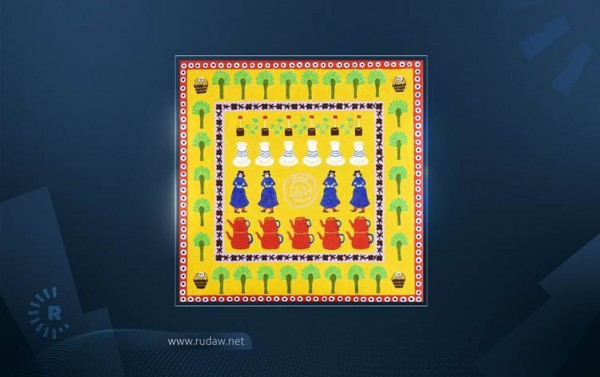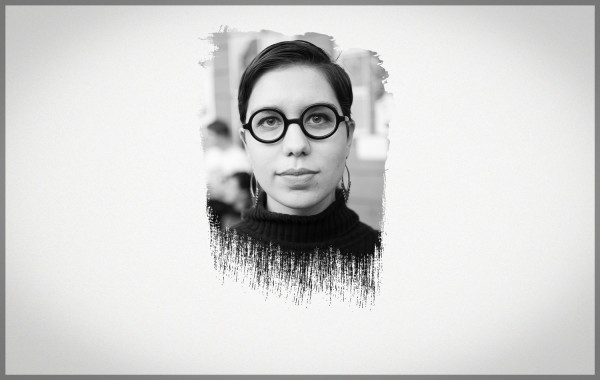
"Chai", by Esther Elia
Ishtartv.com
– rudaw.net
August 26, 2020
Yasmine Mosimann
With the curtains on most
cultural events and performances worldwide drawn by the coronavirus, artists,
curators, critics, and fans alike have had to radically reimagine how they
produce, exhibit and support art.
Curators Akadina Yadegar and Nardin Sarkis have taken on this challenge by
organizing the first virtual exhibition of contemporary Assyrian art, entitled
'Diaspora in Bloom'. Rather than showing the works of the six featured artists
on a still website, they have used an online simulation to recreate the
experience of walking through a gallery.
Stepping over the gallery threshold, visitors use their mouse to guide
themselves beneath the exhibit’s bright lights. While the emptiness of the
virtual space is characteristic of this very particular time, the upbeat
soundtrack by Eden Danilo and a wider celebration of Assyrian life and culture
breathe life back into the room.
This virtual meditation on the art of a globally dispersed Assyrian community
comes at a time when many people are exceptionally wary of physical proximity
and need new ways to connect with others.
“In a world on lockdown many are just discovering the harshness of borders that
Assyrians have always known. Yet digital spaces designed for computerised
community help us blur the reality of man-made boundaries,” reads a message
from the curators on a wall at the gallery’s entrance.
Rudaw English spoke to San Francisco-based visual artist Esther Elia, whose
work features prominently in the exhibit. In an interview conducted by email,
the Assyrian-Irish-American illustrator explains how she uses Assyrian
histories both broad and intimate to understand not only her identity, but her
place in the world.
Rudaw English: In a way, quarantine might be the perfect circumstance for an
art show on a diaspora, which is dispersed by nature. I know you recently took
part in a physical exhibit — how do you feel a virtual exhibition will change
the way people engage with your work?
Esther Elia: The biggest change for me is starting to rethink my art for a
virtual audience — my pieces created in the past were huge paintings meant to
engulf the viewer, overwhelm them with colour and scale just as I am
overwhelmed when attempting to tell the stories of my people, of my family. The
oral histories of our people are complicated, colourful, painful, large. The
question I'm asking myself is, how do I create a sense of largeness online?
When someone is viewing my pieces potentially from a screen as small as a
phone? How do I communicate a 3D sculpture effectively on a 2D screen? A big
part of me just wants to wait until things return to "normal" so I
can continue in the path I've been on, but another big part of me is excited at
the restrictions and new rules — forcing me to find a way to thrive
artistically in an online setting.
Ultimately I don't have a concrete answer, other than to say that some of my
favorite artistic work came from post-war Poland at a time when as a country,
they had little access to supplies, current art technology, or freedom of
expression, yet managed to create some of the most innovative art posters,
writing, music, and surrealist animations. Though we don't want limitations,
they ultimately force us to rethink and grow in ways we wouldn't be able to if
things are functioning normally.
You, like many other Assyrian artists, use symbolism from antiquity in your
work. What do they mean to you?
The history of the Middle East is muddled at best, and at worst told from the
wrong perspectives. As a region, it's been really difficult for me to find
concrete, unbiased histories, which is why I have been relying on oral
histories to be the foundational research for my work on being Assyrian. As a
minority group within the Middle East, finding any sort of history becomes even
more of a challenge, which I think is why so many Assyrian artists use ancient
works as a jumping off point to talk about being Assyrian — the antiquities can
be found in museums and are identified explicitly as Assyrian — some of the
only objects in our world that we can grasp onto and say with confidence,
"This is ours!!"
Our struggle is identifying in this day and age similar things that we can
claim as "ours." With no recognised country, with a huge number of
our population living in diaspora, it is comforting to look to antiquity as
something that is ours — not only because we say so, but because institutions
and academia corroborate that specific history. A huge part of being Assyrian
for me has been a lifetime of saying, "we exist." Antiquities verify
that just as we exist now, we existed historically as well. Ancient symbolism
is kept alive because it has been necessary for our survival, for evidence to
maintain the connection to our indigenous land.
What is Assyrian art to you? How
do you see your work within its trajectory?
Assyrian art is any creative expression by an Assyrian person.
I see my work as a sort of diasporic prophecy for immigrated Assyrians. My
family fled Persia in the early 1920s, and were in America by the mid-1930s,
which makes me a third-generation American. I grew up in a mixed household that
no longer spoke Assyrian. Though I was born in America, raised to speak
English, and was a mix of two ethnicities — effectively the American dream
incarnate, completely assimilated — there was something I felt that was still
missing.
My work addresses Assyrians in diaspora — kids who were born outside of the
Middle East and feel the ache of a culture they belong to but don't know
intimately. Who feel like there is something missing inside of them that they
either run to or run away from. My work is the new reality of being Assyrian —
that it's not something that will continue to be handed to you by the place you
live in, instead that it's a choice. There is a lot of fear from immigrant
communities that their cultures will be lost, that their kids won't care about
the traditions associated with ethnicity. My work explores the reality of that
and transforms fearful speculation to relaying stories of an actual lived
experience, that talks about my pursuit of being Assyrian in America.
Among your larger body of work, I've noticed two strands – one depicts moments
based off family photographs and stories, with more muted and cold colours, and
the other has less specific narratives, utilises symbols in brighter colours,
largely on objects or of objects. What prompted these two different series?
The series based on family photos is supposed to have a certain coldness,
other-worldliness. This series is based on the struggle of trying to get to
know who my ancestors were through black and white photos. The search is not
rewarding, I only get snippets of information about them from my family members
that knew them. I'm trying to see where I fit in with our history, and feel a
block, an inaccessibility. I think this block comes from my ancestors not
talking about what they went through, instead shutting themselves down when it
came to the genocides. It created a river between them and their offspring,
fueling decisions out of trauma, choosing assimilation out of fear. I ask them
my questions on top of the paintings, and they stare, not answering me. In a
lot of ways, it is conveying the relationship to Assyrian history – there are
so many questions and very few gratifying answers. The most poignant question
is, "who am I, and how did I end up here, the way that I am?"
The brighter, more folksy paintings draw inspiration from the colour and design
of Persian carpets. These works address the pieces that still feel accessible
to me — the food being a big one! Growing up with Persian carpets covering the
house is an accessible memory for me, a tradition that I continue in my own
life. The food is also something that wasn't assimilated out, a piece of the
homeland that I feel intimately connected to. The colours are brighter and
happier because it is conveying places of comfort for me.
Diaspora in Bloom runs through August 30. You can visit the show here.

Esther Elia
|